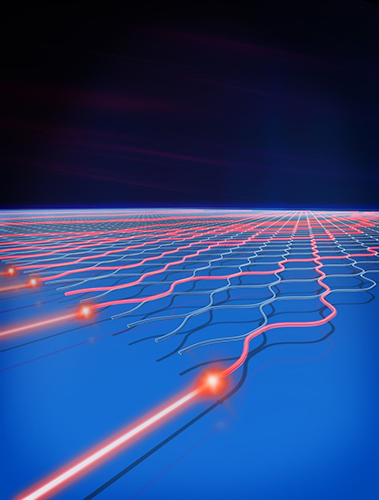

The machine jointly developed by USTC, the Shanghai Institute of Microsystem and Information Technology of the Chinese Academy of Sciences, and a national research center of concurrent computer engineering technology realized Gaussian Boson Sampling (GBS), which indicates good prospects for practical application.
A section of the light-based quantum computer created by researchers at USTC [IMAGE: USTC]
A group of Chinese scientists led by Pan Jianwei and Lu Chaoyang of the University of Science and Technology of China (USTC) have developed a prototype quantum computer which they named Jiuzhang, after the ancient Chinese mathematics text Jiuzhang Suanshu, or Nine Chapters on the Mathematical Art.
Jiuzhang was recently able to manipulate 76 quantum bits, or qubits, for calculations.
The machine jointly developed by USTC, the Shanghai Institute of Microsystem and Information Technology of the Chinese Academy of Sciences, and a national research center of concurrent computer engineering technology realized Gaussian Boson Sampling (GBS), which indicates good prospects for practical application.
According to existing theory, the quantum computing system can implement large-scale GBS 100 trillion times faster than the world’s fastest supercomputer.
The same task that Jiuzhang can finish in one minute would take a supercomputer about 100 million years to complete. Also, its speed is 10 billion times faster than Google’s Sycamore, a 53-qubit computer.
The achievement shows that China has reached the first milestone in quantum computing — quantum computational advantage, or quantum supremacy.
Relevant academic papers were published online on December 4 in the journal Nature.
Quantum computers have super fast concurrent computing ability in principle and can accelerate exponentially compared with classical computers in some fields of great social and economic value (such as cryptanalysis, big data optimization, material design, and drug analysis) through specific algorithms.

Schematic diagram of quantum interference of light [IMAGE: USTC]
At present, building quantum computers has become one of the biggest challenges of the world’s frontier scientific and technological research, and has been the focus of competition among developed countries in Europe and the United States.
Pan’s team has been a global leader in optical quantum information processing. In 2017, it built the world’s first quantum computing prototype that goes beyond the early classic computer (ENIAC). In 2019, the team further developed the world’s highest performance single photon source with deterministic polarization, high purity, high homogeneity and high efficiency, realizing Bose sampling with 20-photon input and 60 mode interference circuits. The output complexity was equivalent to 48 qubits of Hilbert space, approaching the “quantum computational advantage”.
According to the current optimal classical algorithm, Jiuzhang can process GBS 100 trillion times faster than Fugaku, the most recent world’s No. 1 supercomputer, and is 10 billion times faster than the 53-qubit quantum computing prototype “Sycamore” unveiled by Google last year.
This achievement firmly establishes China’s position as one of the global leaders in quantum computing research, and lays a technical foundation for the realization of a large-scale quantum simulator that can solve important practical problems in the future.
In addition, the GBS algorithm based on the Jiuzhang quantum computing prototype boasts great potential in application in graph theory, machine learning, quantum chemistry and other fields, and exemplifies an important trend of future development.
The journal reviewers hailed the Chinese machine as a “state-of-the-art experiment” and a “major achievement” in quantum computing. Scientists expect that the research can stimulate more efforts in classical algorithm simulation and have pinned high hopes on it.
The quantum supremacy experiment is a race between faster classical algorithms and the continuous improvement of quantum computing hardware. However, quantum parallelism will ultimately produce computing power that classical computers can’t reach.
The project was supported by the Chinese Academy of Sciences, Anhui Province, the Ministry of Science and Technology, Shanghai Municipality and the National Natural Science Foundation of China.
Source: University of Science and Technology of China